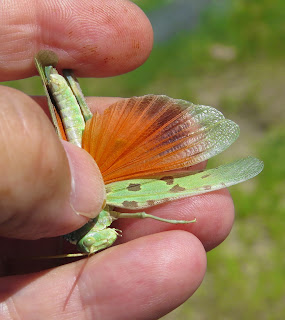The band-winged grasshoppers in the subfamily Oedipodinae (family Acrididae) are easy to love. They are colorful and noisy in flight, seldom qualify as pests of agriculture or rangeland, and are endlessly diverse. A case in point is the beautiful Blue-winged Grasshopper, Trimerotropis cyaneipennis.
I first became acquainted with this species during childhood trips to eastern Oregon. They were fairly plentiful around Fort Rock in northern Lake County, but a real challenge to catch, even with a net. Nothing has changed, it took me several tries to net one that Heidi and I encountered in Water Canyon in the Magdalena Mountains of New Mexico last Sunday. I wanted to show Heidi, and my readers here, the blue-green hind wings that give this species its common name.
Like all members of the genus Trimerotrois, T. cyaneipennis is incredibly cryptic when at rest among rocks, or on bare soil. The front wings, called tegmina (singular is "tegmen"), are narrow and in this case speckled with brown, gray, and black, creating vague bands. The hind wings are used in flight, and fold like a Japanese fan, accordion-like, when not in use, concealed beneath the tegmina.
Even if you can follow the flight path of one of these insects, and note where it lands again, good luck spotting it unless it moves. Actually, it might even walk a short distance once it does land, making it even more maddening to locate.
The cloak of (near) invisibility works well, despite the fact that these are not small creatures. Adult males measure 25-35 millimeters, females 28-40 millimeters. Besides the blue hind wings, they can be identified in part by the bright blue tibia ("shin") segment of the hind leg, and the blue tint on the abdomen, visible in the image below.
This grasshopper is most common in rugged, mountainous terrain and canyons at elevations between 3,000 and, 8,500 feet. Look for them along gravel roads, and volcanic soils, especially at the base of steep slopes. They tend to favor oak, pinyon-juniper, or pine forests west of the Rocky Mountains from southeast Washington, Idaho, eastern Oregon, California, Nevada, Utah, southwest Colorado, Arizona, western New Mexico and extreme west Texas. They also range just across the Mexican border.
You might hear this grasshopper when it takes flight, as it generates a loud crackling sound as the veins of the hind wing rubs against the underneath surface of the tegmen. This is called "crepitation," and can be initiated at will by the insect, such that it can also fly silently.
There is continuing debate over the exact status of this species, and in southeast Wyoming, central Colorado, and much of eastern New Mexico, it is replaced by the closely-related "Brother's Band-winged Grasshopper," Trimerotropis fratercula. That species has yellow, or greenish-yellow hind wings, but even T. cyaneipennis does not always have obviously blue or turquoise wings.
Since this is more or less a "wilderness" grasshopper that does not eat crops or rangeland forage, it is not considered a pest. All the more reason to enjoy an encounter with this blue-winged beauty.
Sources: Bentley, Tom and David Ferguson. 2007. "Species Trimerotropis cyaneipennis - Blue-winged Grasshopper," Bugguide.net.
Capinera, John L., Ralph D. Scott, and Thomas J. Walker. 2004. Field Guide to Grasshoppers, Katydids, and Crickets of the United States. Ithaca: Comstock Publishing Associates (Cornell University Press). 249 pp.
Helfer, Jacques R. 1972. How to Know the Grasshoppers, Cockroaches and Their Allies (2nd Ed.). Dubuque, Iowa: Wm. C. Brown Company Publishers. 359 pp.



































